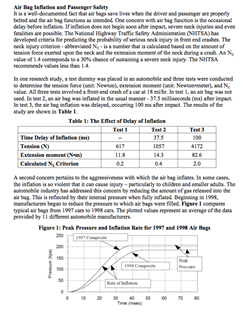 Air Bag Inflation and Passenger Safety
Air Bag Inflation and Passenger Safety
Resource:
Science Reasoning Center: Air Bag Inflation and Passenger Safety
Grade Level: High School
Description:
This passage describes the factors that affect the safe functioning of air bags. Data regarding delay time before inflation, inflation rates and inflation pressures are presented in the form of a table and a graph. Questions target a student's ability to find basic information in a body of text, to recognize patterns within a table of data, to draw conclusions that are consistent with data, to translate information from a table to a graph, to interpret the slope of a graph, and to recognize the implications of experimental findings.
Performance Expectation:
HS-PS2-3 Apply scientific and engineering ideas to design, evaluate, and refine a device that minimizes the force on a macroscopic object during a collision.
This activity aligns with the three dimensions of the Next Generation Science Standards in the manner described below:
| Forces and Motion (HS-PS2.A.3): If a system interacts with objects outside itself, the total momentum of the system can change; however, any such change is balanced by changes in the momentum of objects outside the system. |
Though not explicitly stated in this data presentation, the reader is considering the physical effects of a quick momentum change on the body. With or without an effective airbag, the momentum change of a body that is brought to rest will be the same. What will yield a ‘safer’ collision is when the airbag is able to minimize the force on the body by maximizing the time over which the body comes to rest. As the reader explores this data presentation, it becomes clear that despite the three test dummy’s experiencing the same momentum change, the airbag’s delay in inflating as well as the airbag’s inflation pressure significantly impact the force and time over which this momentum change must occur. |
| Cause and Effect: Systems can be designed to cause a desired effect. |
By exploring how the delay time and pressure inflation rates of airbags affect the safety of passengers, students can identify the causes which enhance the protection of individuals in car crashes. Furthermore, questions at the end of the passage require the student to reason through this cause and effect relationship. |
| Scale, Proportion, and Quantity: Algebraic thinking is used to examine scientific data and predict the effect of a change in one variable on another. |
Airbags inflate over very short periods of time and must be measured in milliseconds. Since all time intervals mentioned in this passage are very short in duration, as the student explores this data presentation he or she will understand how even hundredths of a seconds can mean the difference between life and death. Students will also see an inverse relationship between the airbag inflation delay time and passenger safety. |
| Analyzing and Interpreting Data: Analyze data in order to make valid and reliable scientific claims or determine an optimal design solution. |
Analyzing and interpreting data tables with multiple rows and columns and reading graphs with multiple data sets plotted is a challenging yet important skill for scientists. Questions 1, 4, 6, 7 and 8 require students to analyze data from such data presentations in order to make a scientific claim and determine the safest conditions for airbag inflation. |
| Constructing Explanations and Designing Solutions: Refine a solution to a complex real-world problem, based on scientific knowledge, student-generated sources of evidence, prioritized criteria, and tradeoff considerations. |
While it is well understood that airbags save lives, this passage allows the reader to delve deeper in understanding how to improve an airbag’s effectiveness. Questions 3 and 5 at the close of this passage, for example, ask the reader to both construct an explanation as well as identify design characteristics that will promote passenger safety. |
| Engaging in Argument from Evidence: Evaluate competing design solutions to a real-world problem based on scientific ideas and principles, empirical evidence, and logical arguments regarding relevant factors. |
Empirical evidence is at the core of scientific arguments. As airbag delay times and inflation air pressure are examined in this case study, the reader is asked to use numerical and graphical evidence to support a claim. Questions 2 and 9 at the end of this passage serve as examples of how a scientist or engineer evaluates differing airbag characteristics (inflation delay time and air pressure) to address a real-world problem using empirical evidence and logical reasoning. |
Associated Reading from The Physics Classroom
Other Supporting Pages at The Physics Classroom:
View Infographic.
(Coming Soon)
Search the NGSS Corner
Maybe you're looking for something really specific that pertains to a desired topic and emphasizes one or more of the listed NGSS dimensions. Why not try a search of this section of our website? Simply select from one or more of the pull-down menus and click Search This page will reload and a collection of possibilities will be displayed in this section of the page and sorted by relevancy.